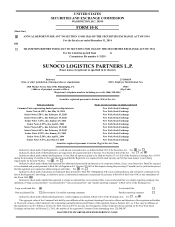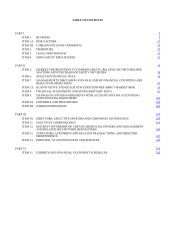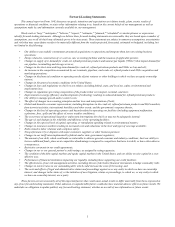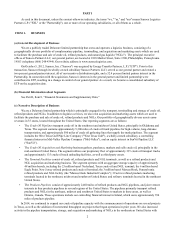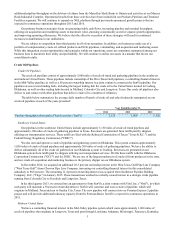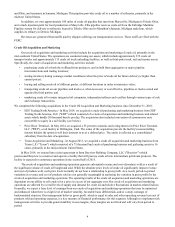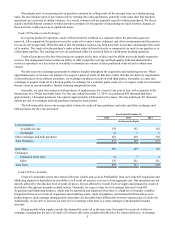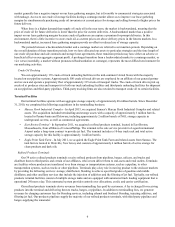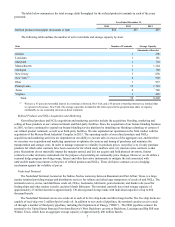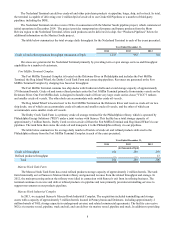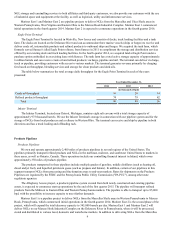Sunoco 2014 Annual Report Download - page 7
Download and view the complete annual report
Please find page 7 of the 2014 Sunoco annual report below. You can navigate through the pages in the report by either clicking on the pages listed below, or by using the keyword search tool below to find specific information within the annual report.
5
We mitigate most of our pricing risk on purchase contracts by selling crude oil for an equal term on a similar pricing
basis. We also mitigate most of our volume risk by entering into sales agreements, generally at the same time that purchase
agreements are executed, at similar volumes. As a result, volumes sold are generally equal to volumes purchased. We do not
acquire and hold futures contracts or other derivative products for the purpose of speculating on crude oil price changes, as
these activities could expose us to significant losses.
Crude Oil Purchases and Exchanges
In a typical producer's operation, crude oil flows from the wellhead to a separator where the petroleum gases are
removed. After separation, the producer treats the crude oil to remove water, sediment, and other contaminants and then moves
it to an on-site storage tank. When the tank is full, the producer contacts our field personnel to purchase and transport the crude
oil to market. The crude oil in the producer's tanks is then either delivered directly or transported via truck to our pipeline or to
a third-party pipeline. The trucking services are performed either by our truck fleet or a third-party trucking operation.
Crude oil purchasers who buy from producers compete on the basis of price and the ability to provide highly responsive
services. Our management believes that our ability to offer competitive pricing and high-quality field and administrative
services to producers is a key factor in our ability to maintain our volume of lease purchased crude oil and to obtain new
volume.
We also enter into exchange agreements to enhance margins throughout the acquisition and marketing process. When
opportunities arise to increase our margin or to acquire a grade of crude oil that more nearly matches our delivery requirements
or the preferences of our refinery customers, we exchange our physical crude oil with third parties. Generally, we enter into
exchanges to acquire crude oil of a desired quality in exchange for a common grade crude oil or to acquire crude oil at locations
that are closer to our end markets, thereby reducing transportation costs.
Generally, we enter into contracts with producers at market prices for a term of one year or less, with a majority of the
transactions on a 30-day renewable basis. For the year ended December 31, 2014, we purchased 402 thousand bpd from
approximately 3 thousand producers who operate approximately 64 thousand active leases. We also undertook 471 thousand
barrels per day of exchanges and bulk purchases during the same period.
The following table shows our average daily volume for crude oil lease purchases and sales, and other exchanges and
bulk purchases for the years presented:
Year Ended December 31,
2014 2013 2012
(in thousands of bpd)
Lease purchases:
Available for sale 378 332 283
Exchanged 14 7 6
Other exchanges and bulk purchases 481 410 384
Total Purchases 873 749 673
Bulk Sales 483 419 342
Exchanges:
Purchased at the lease 14 7 6
Other 372 321 321
Total Sales 869 747 669
Crude Oil Price Volatility
Crude oil commodity prices have historically been volatile and cyclical. Profitability from our Crude Oil Acquisition and
Marketing segment is dependent on our ability to sell crude oil at prices in excess of our aggregate cost. Our operations are not
directly affected by the absolute level of crude oil prices, but are affected by overall levels of supply and demand for crude oil
and relative fluctuations in market-related indices. Generally, we expect a base level of earnings from our Crude Oil
Acquisition and Marketing business, which may be optimized and enhanced when there is a high level of market volatility.
Integration between our crude oil acquisition and marketing assets, crude oil pipelines, and terminal facilities allows us to
further improve upon earnings during periods when there are favorable basis differentials between various types of crude oils.
Additionally, we are able to increase our base level of earnings when there is a steep contango or backwardated market
structure.
During periods when supply exceeds the demand for crude oil in the near term, the market for crude oil is often in
contango, meaning that the price of crude oil for future deliveries is higher than the price for current deliveries. A contango

